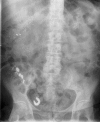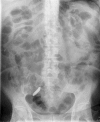Laparoscopic appendectomy for elemental mercury sequestration in the appendix: A case report
- PMID: 31123676
- PMCID: PMC6511929
- DOI: 10.12998/wjcc.v7.i9.1038
Laparoscopic appendectomy for elemental mercury sequestration in the appendix: A case report
Abstract
Background: Despite negligible absorption of elemental mercury after acute ingestion, retention in the appendix with subsequent local and systemic complications is possible. We present a case of elemental mercury sequestration in the appendix, managed by laparoscopic appendectomy.
Case summary: A 57-year-old Caucasian female was found unconscious following application of long-lasting insulin detemir and ingestion of elemental mercury in a suicidal attempt. Diagnostic investigations revealed several radiopaque collections in the gastrointestinal (GI) tract and elevated mercury levels in the blood. Much of the ingested elemental mercury was eliminated from the GI tract with stools stimulated by several enemas. However, a significant amount of mercury remained sequestrated in the appendix despite all conservative measures. Consequently, following deliberations by an interdisciplinary team of specialists, laparoscopic appendectomy was performed 29 d after the mercury ingestion. The surgery itself and postoperative course were uneventful.
Conclusion: Since conservative measures are often unsuccessful in the management of mercury retention in the appendix, surgery remains a compelling option to prevent possible associated complications.
Keywords: Appendectomy; Appendix; Case report; Mercury ingestion; Mercury poisoning; Mercury retention.
Conflict of interest statement
Conflict-of-interest statement: The authors declare no conflict of interests with regard to this case report.
Figures



Similar articles
-
Strictly-controlled techniques are required in laparoscopic appendectomy for elemental mercury sequestration in the appendix: a case report.J Int Med Res. 2023 Jun;51(6):3000605231183702. doi: 10.1177/03000605231183702. J Int Med Res. 2023. PMID: 37389592 Free PMC article.
-
Intentional ingestion of elemental mercury requiring multi-step decontamination and prophylactic appendectomy: a case report and treatment proposal.Clin Toxicol (Phila). 2018 Jan;56(1):69-73. doi: 10.1080/15563650.2017.1338346. Epub 2017 Jun 26. Clin Toxicol (Phila). 2018. PMID: 28650684
-
Conservative management of elemental mercury retained in the appendix.Clin Toxicol (Phila). 2008 Nov;46(9):831-3. doi: 10.1080/15563650701846288. Clin Toxicol (Phila). 2008. PMID: 18608269
-
Management of ingested foreign bodies within the appendix: a case report with review of the literature.Am J Gastroenterol. 1997 Dec;92(12):2295-8. Am J Gastroenterol. 1997. PMID: 9399774 Review.
-
Ingested foreign bodies within the appendix: A 100-year review of the literature.Dig Dis. 1998 Sep-Oct;16(5):308-14. doi: 10.1159/000016880. Dig Dis. 1998. PMID: 9892790 Review.
Cited by
-
Strictly-controlled techniques are required in laparoscopic appendectomy for elemental mercury sequestration in the appendix: a case report.J Int Med Res. 2023 Jun;51(6):3000605231183702. doi: 10.1177/03000605231183702. J Int Med Res. 2023. PMID: 37389592 Free PMC article.
-
Peritonitis Due to Appendicitis Related to Mercury Sequestration: An Unusual Peruvian Case Report.Cureus. 2022 Aug 4;14(8):e27667. doi: 10.7759/cureus.27667. eCollection 2022 Aug. Cureus. 2022. PMID: 36134106 Free PMC article.
References
-
- Michielan A, Schicchi A, Cappuccio R, Lonati D, Lamboglia F, Vitalba A, Caroli A, Crevani M, Locatelli CA, Betetto G. Intentional ingestion of elemental mercury requiring multi-step decontamination and prophylactic appendectomy: a case report and treatment proposal. Clin Toxicol (Phila) 2018;56:69–73. - PubMed
-
- Caravati EM, Erdman AR, Christianson G, Nelson LS, Woolf AD, Booze LL, Cobaugh DJ, Chyka PA, Scharman EJ, Manoguerra AS, Troutman WG American Association of Poison Control Centers. Elemental mercury exposure: an evidence-based consensus guideline for out-of-hospital management. Clin Toxicol (Phila) 2008;46:1–21. - PubMed
Publication types
LinkOut - more resources
Full Text Sources

